The Colonna dell'Abbondanza is a monumental column located in the Piazza della Repubblica in Florence, region of Tuscany, Italy.

The Colonna dell'Abbondanza is a monumental column located in the Piazza della Repubblica in Florence, region of Tuscany, Italy.

While the open Piazza we see today dates to the 19th-century clearing of the Mercato Vecchio in Florence, a column at the site was erected in the 15th century, at the intersection of the Roman grid roads, the Cardo and Decumanus Maximus, thus once forming the center of Ancient Roman Florence.
It is likely a monument at the site was present in Ancient Florence, this column, made from gray granite from Elba, was erected initially in 1430–1431 by the civic officers of the neighborhood. At the summit, originally was placed a pietra serena statue by Donatello, depicting an allegory of la Dovizia (Abundance), holding a cornucopia, a theme befitting the surrounding marketplace.
Attached to the column were two chains: one rung the open and close of market, while the other was used to chain swindlers and insolvent debtors for public shaming. In this it served a similar role to the Column of the Vicariate in Naples.


Weather-worn, the head of Donatello's statue fell and was destroyed, the statue was removed in 1721, and replaced by a marble statue by Giovanni Battista Foggini. [1]
During the clearing of the Piazza between 1885 and 1895, the column was dismantled, and the components stored in various sites. Only in 1956, under the engineer Giulio Cesare Lensi Orlandi Cardini, and funded by the local Azienda del Turismo, the column was reassembled with a bronze copy of Foggini's statue by Mario Moschi. [2]
The column is sited some two meters from its original position. [3]
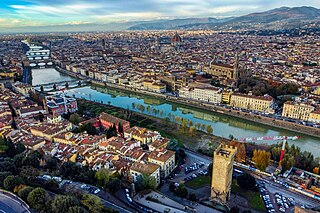
Florence is the capital city of the Italian region of Tuscany. It is also the most populated city in Tuscany, with 360,930 inhabitants in 2023, and 984,991 in its metropolitan area.

Florence Cathedral, formally the Cathedral of Saint Mary of the Flower, is the cathedral of Florence, Italy. It was begun in 1296 in the Gothic style to a design of Arnolfo di Cambio and was structurally completed by 1436, with the dome engineered by Filippo Brunelleschi. The exterior of the basilica is faced with polychrome marble panels in various shades of green and pink, bordered by white, and has an elaborate 19th-century Gothic Revival façade by Emilio De Fabris.

Piazza della Signoria is a w-shaped square in front of the Palazzo Vecchio in Florence, Italy. It was named after the Palazzo della Signoria, also called Palazzo Vecchio. It is the main point of the origin and history of the Florentine Republic and still maintains its reputation as the political focus of the city. It is the meeting place of Florentines as well as the numerous tourists, located near Palazzo Vecchio and Piazza del Duomo and gateway to Uffizi Gallery.

The Loggia dei Lanzi, also called the Loggia della Signoria, is a building on a corner of the Piazza della Signoria in Florence, Italy, adjoining the Uffizi Gallery. It consists of wide arches open to the street. The arches rest on clustered pilasters with Corinthian capitals. The wide arches appealed so much to the Florentines that Michelangelo proposed that they should be continued all around the Piazza della Signoria.
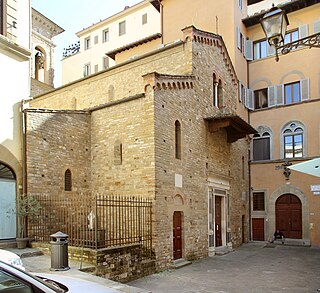
The Church of Santi Apostoli is a Romanesque-style, Roman Catholic church in the historic center of Florence, in the Tuscany region of Italy. It is among the oldest church buildings in Florence.

Palazzo Mozzi or Palazzo de' Mozzi is an early Renaissance palace, located at the end of the Piazza de' Mozzi that emerges from Ponte alle Grazie and leads straight to the palace where via San Niccolò becomes via de' Bardi in the Quartiere of Santo Spirito in the Oltrarno section of Florence, region of Tuscany, Italy. The 13th-century palace housed the gallery of the highly successful antiquarian Stefano Bardini, of which the remnants were left to the commune, where they assembled the Museo Bardini or Mozzi Bardini, displaying Florentine art and artifacts up to the early Renaissance. The gardens elaborated against the hillside behind the palace were added mainly by Bardini.

Santa Trinita is a Roman Catholic church located in front of the piazza of the same name, traversed by Via de' Tornabuoni, in central Florence, Tuscany, Italy. It is the mother church of the Vallumbrosan Order of Monks, founded in 1092 by a Florentine nobleman. South on Via de' Tornabuoni is the Ponte Santa Trinita over the river Arno; across the street is the Palazzo Spini Feroni.
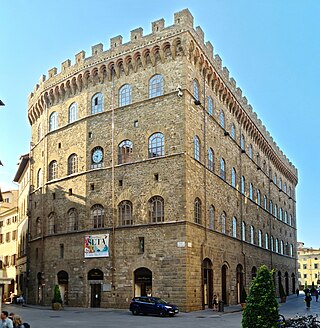
Palazzo Spini Ferroni is a large Gothic palace located along Via de' Tornabuoni at the corner of Piazza Santa Trinita, in central Florence, Tuscany, Italy. It stands across from the church of Santa Trinita.

Piazza della Repubblica is a city square in Florence, Italy. It was originally the site of the city's forum; then of its old ghetto, which was swept away during the improvement works, or Risanamento, initiated during the brief period when Florence was the capital of a reunited Italy—work that also created the city's avenues and boulevards. At that time, the Loggia del Pesce from the Mercato Vecchio was also moved to Piazza Ciompi. The square's Giubbe Rosse cafe has long been a meeting place for famous artists and writers, notably those of Futurism.

The Loggia del Mercato Nuovo, popularly known as the Loggia del Porcellino, is a building in Florence, Italy. It is so called to distinguish it from the Mercato vecchio that used to be located in the area of today's Piazza della Repubblica.

The Marzocco is the heraldic lion that is a symbol of Florence, and was apparently the first piece of public secular sculpture commissioned by the Republic of Florence, in the late 14th century. The lion stood at the heart of the city in the Piazza della Signoria at the end of the platform attached to the Palazzo Vecchio called the ringhiera, from which speakers traditionally harangued the crowd. This is now lost, having weathered with time to an unrecognizable mass of stone.
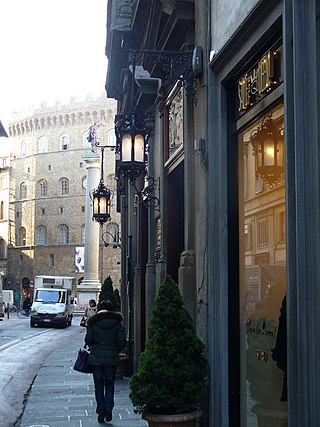
Via de' Tornabuoni, or Via Tornabuoni, is a street at the center of Florence, Italy, that goes from Antinori square to Ponte Santa Trinita, across Santa Trinita square, distinguished by the presence of fashion boutiques.
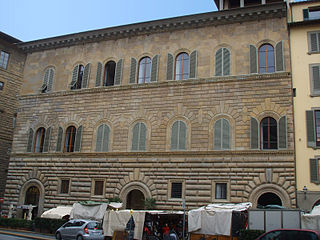
Palazzo Gondi is a palace in Florence, Italy, located a block from Piazza della Signoria. It was built in 1490 under design by Giuliano da Sangallo, who was inspired by other major works of stately buildings in the city, such as Palazzo Medici and Palazzo Strozzi. Among the elements borrowed from these earlier works are the cube-shape set around a central courtyard, the ashlar sloping on each of three floors, and the arched windows.

The Tower or Torre dei Rossi-Cerchi is a reconstructed medieval tower, now part of the Hotel Pitti Palace al Ponte Vecchio, located on Via Guicciardini, corner Borgo San Jacopo, in the Oltrarno district near the entrance to the Ponte Vecchio in Florence, region of Tuscany, Italy.

The Column of Santa Felicita is a monumental column with Corinthian capital standing in front of the church of Santa Felicita in Florence, region of Tuscany, Italy.

Column of Justice is an ancient Roman marble Doric column re-erected by the Florentine Medici dynasty in the Renaissance as a free-standing victory monument with a porphyry statue of Justice at the top. It stands in the Piazza Santa Trinita, in central Florence, Italy.
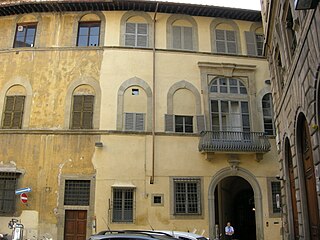
The Palazzo or Casa Martelli was a residential palace, and since 2009, a civic museum displaying in situ the remains of the original family's valuable art collection, as well as its frescoed rooms. The palace is located on Via Ferdinando Zannetti 8 near the corner with Via Cerretani in central Florence, region of Tuscany, Italy.

Florentia was a Roman city in the Arno valley from which Florence originated. According to tradition, it was built by the legions of Gaius Julius Caesar in 59 BC; however, the prevailing hypothesis dates the foundation of the city to the Augustan period.

The palazzo dell’Arcone di Piazza is a civil building in the historical centre of Florence, located at Piazza della Repubblica 5, corner Via degli Anselmi 2, Via Pellicceria, Via degli Strozzi 1- 2, Via de' Brunelleschi 5.